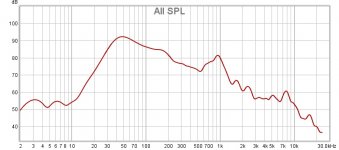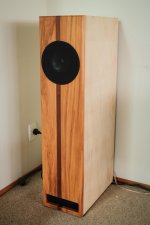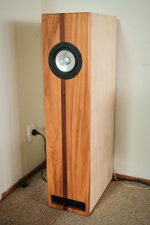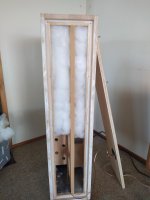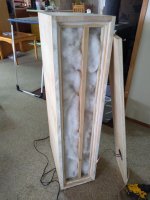Hi all,
First post here but have been lurking for a while. Based in NZ at the bottom of the world (almost), and currently in lockdown so plenty of time to mess with speakers 🙂.
I recently completed a Pensil build for the CHN-110 using some of Scott's plans.
Overall I am really impressed with the driver and cabinet combination.
In the spirit of wanting to understand more around MLTL designs, and also tuning the speaker to my room, I've been tweaking the stuffing placement and density.
The attached image represents a sweep measurement taken 1cm from the vent output. Overall I am fairly happy with the general balance of bass output. I am however curious about the peak at around 940hz. I understand this part of the 'ripple' response of these designs.
My questions - Is there a way to reduce this peak without reducing the low end output? Is this peak a standing wave? Would there be a most effective point to place the stuffing to effect this peak in particular?
FYI - cabinet is currently stuffed to the advised density (around 1lb/cuft), but only in the top half. I found when I had the duration stuffed it reduced low end output too much for my room/preference. Obviously more stuffing would likely reduce the higher peak (and this was supported by my earlier measurements) but also served to reduce overall bass output too much.
Matt
First post here but have been lurking for a while. Based in NZ at the bottom of the world (almost), and currently in lockdown so plenty of time to mess with speakers 🙂.
I recently completed a Pensil build for the CHN-110 using some of Scott's plans.
Overall I am really impressed with the driver and cabinet combination.
In the spirit of wanting to understand more around MLTL designs, and also tuning the speaker to my room, I've been tweaking the stuffing placement and density.
The attached image represents a sweep measurement taken 1cm from the vent output. Overall I am fairly happy with the general balance of bass output. I am however curious about the peak at around 940hz. I understand this part of the 'ripple' response of these designs.
My questions - Is there a way to reduce this peak without reducing the low end output? Is this peak a standing wave? Would there be a most effective point to place the stuffing to effect this peak in particular?
FYI - cabinet is currently stuffed to the advised density (around 1lb/cuft), but only in the top half. I found when I had the duration stuffed it reduced low end output too much for my room/preference. Obviously more stuffing would likely reduce the higher peak (and this was supported by my earlier measurements) but also served to reduce overall bass output too much.
Matt
Attachments
Can we see a picture of your damping? Many of late are not teasing it enuff.
The entire line should be filled. And typically people end up with half to two-thirds of the specified amount in their Pensils.
dave
The entire line should be filled. And typically people end up with half to two-thirds of the specified amount in their Pensils.
dave
Dear Earplay2020,
I think, you don't have to worry about peak at around 940Hz.
I offset the position of vent to accommodate peaks and dips.


I think, you don't have to worry about peak at around 940Hz.
I offset the position of vent to accommodate peaks and dips.


Thanks for the responses.
I've attached a couple of images of current stuffing configuration and front of speaker. I'm aware my current stuffing isn't what is recommended for this design. I had tried that initially, and ended up where I am now through trial and error. It seemed that stuffing throughout the length, especially closer to the terminus end started to reduce the low bass more so than I desired.
Dave - I would however be interested to lightly stuff the whole line for comparison to current arrangement.
Again - I'm not unhappy with the speakers at present, was just interested to learn more about stuffing effects, especially with respect to the observed peak around 940hz. My recent previous builds have all been open baffle so this was my first MLTL.
Cheers,
Matt
I've attached a couple of images of current stuffing configuration and front of speaker. I'm aware my current stuffing isn't what is recommended for this design. I had tried that initially, and ended up where I am now through trial and error. It seemed that stuffing throughout the length, especially closer to the terminus end started to reduce the low bass more so than I desired.
Dave - I would however be interested to lightly stuff the whole line for comparison to current arrangement.
Again - I'm not unhappy with the speakers at present, was just interested to learn more about stuffing effects, especially with respect to the observed peak around 940hz. My recent previous builds have all been open baffle so this was my first MLTL.
Cheers,
Matt
Attachments
Seems due to the small dimensions of the cabinet, around 7" or so.
I agree
I agree
Interesting - I'll need to measure but probably the only dimension close to that would be between side bracing and front/rear speaker wall. (I'm assuming what is being suggested is a standing wave between two parallel surfaces). Will possibly try opening the holes in the brace or making sure stuffing is around it to compare.
I did end up using lighter stuffing for a similar MLTL design for this driver, just the sides of the upper half with 5cm rockwool Sono (in a pillow slope for dust) was enough for this. It's not the same design, but similar. More stuffing like i did before damped the bass output to much. I'm going to rebuild the cabinet (now it's an MDF test model, as it was my first MLTL design) and take pictures and make a cad drawing for it. The driver is at a quarter of the top of the pipe (30cm of the 120cm) in this design. With the pencil it's more at the top which gives more resonances in my sims so more damping may be needed.
Attachments
Last edited:
So to follow up my own query, and for sake of comparison, I measured the vent output (1cm from opening), at the previous stuffing configuration and again with the same weight of stuffing (relatively)evenly distributed throughout the line. Total stuffing weight was 580g (1.27lbs) per cabinet. Stuffing is cheap craft polyfill. This is just under 50% of recommended stuffing weight. UMIK- 1 mic into REW.
As can been seen, this attenuates bass output circa 50hz by around 4db and also smooths some of the other observed peaks.
Thought it may be of interest to others anyway! I spent a lot of time searching the net for similar types of comparisons in Pensil speakers.
If this proves too significant a bass reduction (following extended listening) I may look to reduce weight again but maintain the whole line stuffing. I have no idea of the interaction between the port output and the direct sound coming from the driver itself, and to what degree the vent output translates into in-room FR.
Matt
As can been seen, this attenuates bass output circa 50hz by around 4db and also smooths some of the other observed peaks.
Thought it may be of interest to others anyway! I spent a lot of time searching the net for similar types of comparisons in Pensil speakers.
If this proves too significant a bass reduction (following extended listening) I may look to reduce weight again but maintain the whole line stuffing. I have no idea of the interaction between the port output and the direct sound coming from the driver itself, and to what degree the vent output translates into in-room FR.
Matt
Attachments
I would however be interested to lightly stuff the whole line for comparison to current arrangement.
It looks more teased than many. But too dense at a guess.
I take that back. Looking at the picture in the next post it needs more teasing. A fair amount.
dave
Peaks and dips from the vent opening are reduced by offsetting the vent.
Then the best performance is achieved by using as little sound-absorbing material as possible.
Then the best performance is achieved by using as little sound-absorbing material as possible.
Thanks for the responses.
As I suggested at the outset - I have no qualms with the design. It's great. Just curious to learn more, and how relevant variables interact.
Matt
As I suggested at the outset - I have no qualms with the design. It's great. Just curious to learn more, and how relevant variables interact.
Matt
It looks more teased than many. But too dense at a guess.
I take that back. Looking at the picture in the next post it needs more teasing. A fair amount.
dave
Gotcha - I did do this in a bit of rush to take the measurement so will probably need a little more attention. Based on what I'm hearing in my room, I'm thinking around 450g may be the go. Will post more measurements when I get a chance to play again.
Ask the question, “How long will it take me to tease the polystuff for my TL”.
That will dig out responses from those who have recently had to pull it all out and tease it properly.
dave
That will dig out responses from those who have recently had to pull it all out and tease it properly.
dave
I am also on Dave's list of "people who need to pull the stuffing out and tease it until you can't see straight". I am looking at wool carding tools at this point. While doing it all by hand will be faster and cheaper, if I can come up with a method to tease the material properly using inexpensive tools in a fraction of the time (excluding shipping), I think that a lot of people might benefit.
Peaks and dips from the vent opening are reduced by offsetting the vent.
To a certain extent, but incorrect offsets can actually cause more problems, and ultimately alter the low frequency alignment.
Then the best performance is achieved by using as little sound-absorbing material as possible.
Not so. It depends on the design goals. Amongst other things, the pensils were intended to provide a relatively flat impedance load, which is why they use (out of necessity) more damping than some other quarter-wave designs.
Dear planet10,
What is "compomise" ?
I can't find the Japanese translation on Google.
Dear Scottmoose,
Thanks, I understand.
What is "compomise" ?
I can't find the Japanese translation on Google.
Dear Scottmoose,
Thanks, I understand.
- Home
- Loudspeakers
- Full Range
- CHN 110 Pensil - stuffing effects
